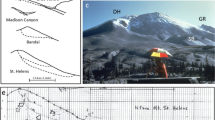Abstract
Investigation of well-exposed volcaniclastic deposits of Shiveluch volcano indicates that large-scale failures have occurred at least eight times in its history: approximately 10,000, 5700, 3700, 2600, 1600, 1000, 600 14C BP and 1964 AD. The volcano was stable during the Late Pleistocene, when a large cone was formed (Old Shiveluch), and became unstable in the Holocene when repetitive collapses of a portion of the edifice (Young Shiveluch) generated debris avalanches. The transition in stability was connected with a change in composition of the erupting magma (increased SiO2 from ca. 55–56% to 60–62%) that resulted in an abrupt increase of viscosity and the production of lava domes. Each failure was triggered by a disturbance of the volcanic edifice related to the ascent of a new batch of viscous magma. The failures occurred before magma intruded into the upper part of the edifice, suggesting that the trigger mechanism was indirectly associated with magma and involved shaking by a moderate to large volcanic earthquake and/or enhancement of edifice pore pressure due to pressurised juvenile gas. The failures typically included: (a) a retrogressive landslide involving backward rotation of slide blocks; (b) fragmentation of the leading blocks and their transformation into a debris avalanche, while the trailing slide blocks decelerate and soon come to rest; and (c) long-distance runout of the avalanche as a transient wave of debris with yield strength that glides on a thin weak layer of mixed facies developed at the avalanche base. All the failures of Young Shiveluch were immediately followed by explosive eruptions that developed along a similar pattern. The slope failure was the first event, followed by a plinian eruption accompanied by partial fountain collapse and the emplacement of pumice flows. In several cases the slope failure depressurised the hydrothermal system to cause phreatic explosions that preceded the magmatic eruption. The collapse-induced plinian eruptions were moderate-sized and ordinary events in the history of the volcano. No evidence for directed blasts was found associated with any of the slope failures.
Similar content being viewed by others
Author information
Authors and Affiliations
Additional information
Received: 28 June 1998 / Accepted: 28 March 1999
Rights and permissions
About this article
Cite this article
Belousov, A., Belousova, M. & Voight, B. Multiple edifice failures, debris avalanches and associated eruptions in the Holocene history of Shiveluch volcano, Kamchatka, Russia. Bull Volcanol 61, 324–342 (1999). https://doi.org/10.1007/s004450050300
Issue Date:
DOI: https://doi.org/10.1007/s004450050300




